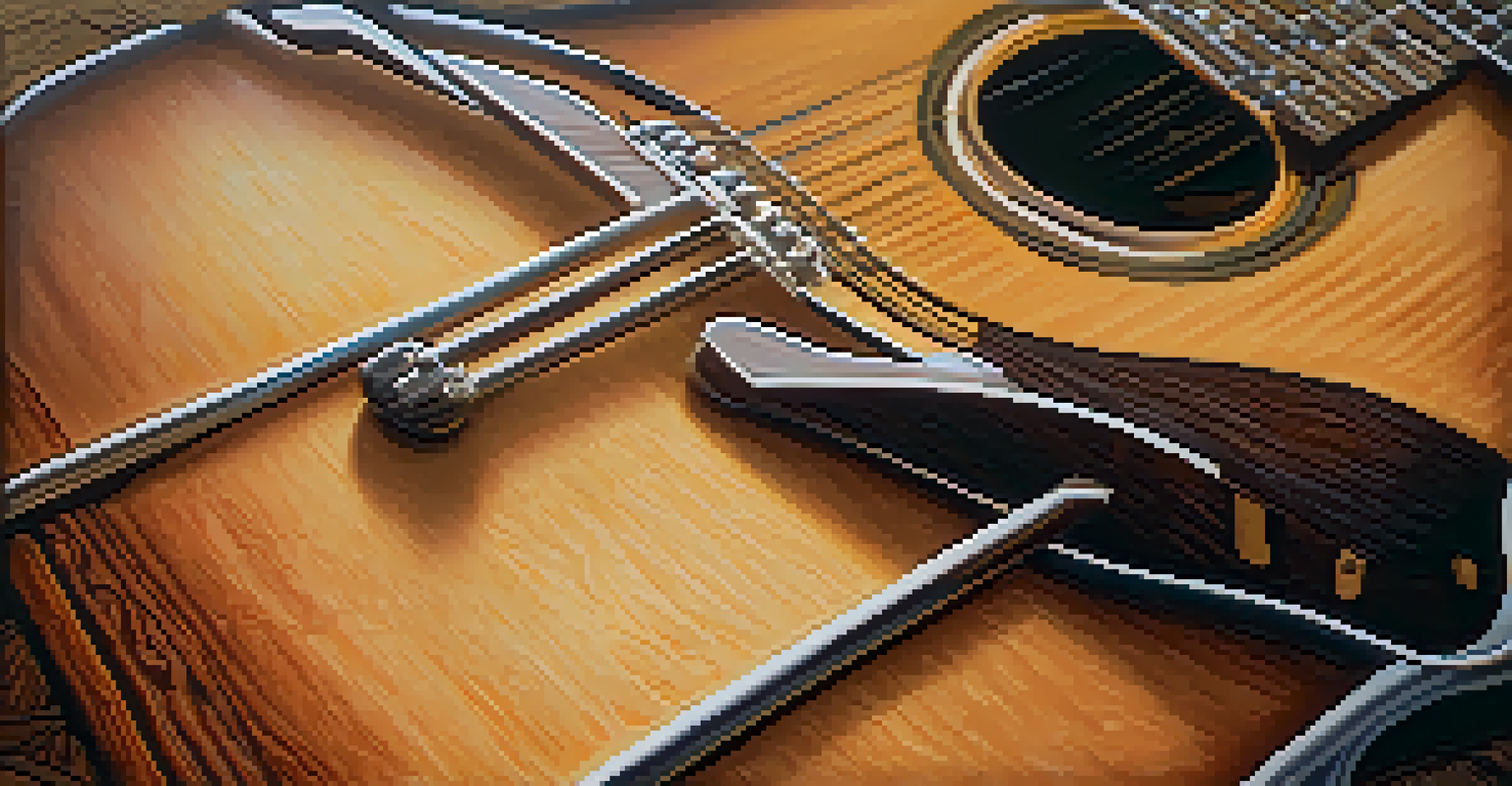Essential Chord Progressions for Songwriters Using Guitar

The Importance of Chord Progressions in Songwriting
Chord progressions are the backbone of any song. They create the emotional landscape that guides the listener's experience. As a songwriter, understanding these progressions helps you craft melodies that resonate.
Music is the shorthand of emotion.
Think of chord progressions as the architecture of a building; they define the structure and flow of your song. Without a solid foundation, even the catchiest melody can fall flat. So, mastering these progressions is crucial for impactful songwriting.
Moreover, different progressions can evoke distinct feelings. For example, a minor chord progression might convey sadness, while a major one often feels uplifting. Knowing how to manipulate these emotions through chords is a powerful tool in your songwriting arsenal.
The Classic I-IV-V Progression: A Songwriter's Best Friend
The I-IV-V progression is often considered the holy grail for songwriters. In the key of C, that translates to the chords C, F, and G. This trio has been the backbone of countless hits across various genres, from rock to pop.

Why is it so effective? The I-IV-V progression creates a satisfying sense of movement and resolution. It’s like a friendly conversation that keeps going, drawing listeners in with its familiar rhythm and flow.
Chord Progressions Shape Emotion
Understanding chord progressions is vital for songwriters, as they create the emotional landscape that guides listeners' experiences.
Many classic songs utilize this progression, like 'Twist and Shout' by The Beatles. If you’re looking to write something catchy and memorable, starting with I-IV-V is always a solid choice.
Exploring the I-V-vi-IV Progression for Modern Hits
The I-V-vi-IV progression has become a staple in contemporary music. In the key of C, this means using C, G, Am, and F. This sequence offers a blend of brightness and depth, making it perfect for heartfelt songs.
The only truth is music.
What makes this progression particularly popular is its versatility. It’s been used in hits like 'Let It Be' by The Beatles and 'With or Without You' by U2, showcasing its ability to fit in various styles while maintaining emotional weight.
When you play this progression, you’ll notice how it effortlessly transitions between feelings of joy and melancholy. This emotional range makes it a fantastic choice for songwriters looking to connect with their audience.
The ii-V-I Progression: A Jazz Essential for Songwriters
If you're venturing into the world of jazz, the ii-V-I progression is essential. In the key of C, this translates to Dm-G-C. This sequence is a favorite among jazz musicians for its smooth transitions and rich harmonic possibilities.
The beauty of the ii-V-I lies in its ability to create tension and resolution. The Dm (ii) chord builds tension that resolves beautifully into the C (I) chord, making your music feel dynamic and engaging.
I-IV-V: The Ultimate Progression
The I-IV-V progression is a beloved cornerstone in songwriting, providing a satisfying sense of movement and familiarity in songs.
Jazz standards like 'Autumn Leaves' often utilize this progression, highlighting its importance in the genre. As a songwriter, incorporating this into your repertoire can add depth and sophistication to your compositions.
The vi-IV-I-V Progression: A Pop Sensation
The vi-IV-I-V progression is a crowd-pleaser in pop music. In C major, it translates to Am-F-C-G. This progression has gained popularity for its catchy, uplifting nature, making it perfect for sing-alongs and anthems.
Songs like 'Someone Like You' by Adele and 'Let It Go' from Disney’s Frozen feature this progression, showcasing its emotional and melodic potential. It’s a great choice for songwriters aiming to create memorable hooks.
The beauty of this progression also lies in its storytelling capability. It allows for a natural build-up and release of emotions, making your songs feel relatable and impactful.
The I-vi-ii-V Progression: A Timeless Classic
The I-vi-ii-V progression offers a nostalgic feel, reminiscent of classic tunes. In C major, it’s C-Am-Dm-G. This progression has a unique charm, often used to evoke a sense of warmth and familiarity.
You’ll find this progression in many doo-wop songs and even some modern tracks. Its cyclical nature creates a comfortable listening experience, making it an excellent choice for romantic ballads and soft rock.
Experiment for Unique Sounds
While classic progressions are essential, experimenting with different combinations and rhythms can lead to distinctive and memorable music.
By incorporating this progression, you tap into the rich history of popular music. It’s a reminder that great songwriting often revolves around timeless structures that resonate with listeners.
The Power of the Blues Progression in Songwriting
The blues progression, typically a 12-bar structure, is foundational in rock and blues music. Using the I-IV-V chords, it creates a raw, emotional sound that captures the essence of the genre. This progression is all about expressing feelings and storytelling.
Songs like 'Sweet Home Chicago' showcase how the blues progression can create a sense of urgency and passion. It’s a fantastic tool for songwriters looking to inject some grit into their music.

By experimenting with the blues progression, you can explore themes of heartache, resilience, and celebration, all while staying true to the genre's roots.
Experimenting with Chord Progressions to Find Your Sound
While it's essential to know these popular progressions, don’t be afraid to experiment! Mixing and matching different progressions can lead to unique sounds that reflect your personal style. Sometimes, the most memorable songs come from unexpected chord combinations.
Try playing around with tempo and rhythm alongside your chords. Changing the pace or adding syncopation can completely transform the feel of your song, making it stand out even more.
Ultimately, songwriting is about finding your voice. So, take these essential progressions as a starting point, but let your creativity guide you to discover what truly resonates with you and your audience.